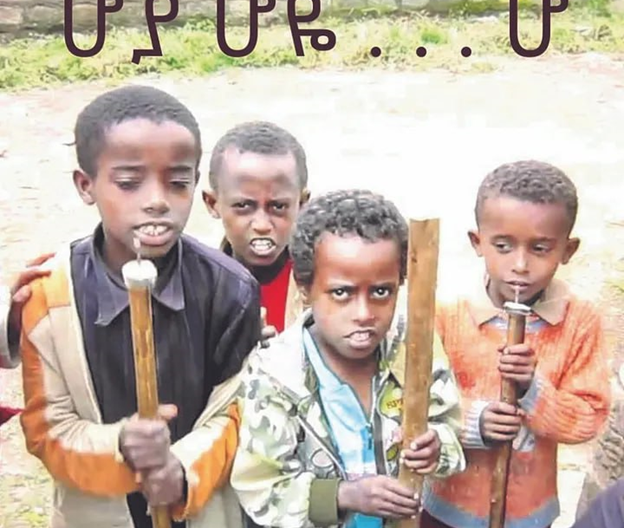
Buhe is here
That bald Buhe
Smear it with butter
So it won’t get greyer
This is a song, which children sing during the Buhe festival, every August 19th. Buhe is one of the holidays celebrated by the Ethiopian Orthodox believers in memorial of the transfiguration of Jesus Christ on Tabor Mountain. During the day, children and youths go around their neighbourhoods and sing songs that reflect the farewell of winter and the coming of a bright summer. The observation also includes a ceremony where residents tie up bundle of sticks together, Chibo, burn them at their neighbourhoods.
While children and the youths go door to door singing and chanting, they will be rewarded with the mulmul bread. There are common songs that memorize and tell the story of Jesus’s transfiguration and the feelings of the three apostles who witnessed the phenomenon. When the children sing of a “bold Buhe” they are referring to the mulmul bread they are receiving after they sung on door step of a residence.
There is a historical attachment to the singing and the backing of the mulmul bread. During the day of Jesus’s transfiguration, shepherds were amazed by the bright light they wouldn’t go home. Parents who were worried about their children went to the place with breads and burning lights.
It is also a celebration that strengthens community togetherness and the values of staying close to one another.
The main song by the children and youths is called and usually starts by “Hoya Hoye”. One boy leads the song and his partners will follow rhythmically. As they finish singing the house wife will bring them the mulmul bread, one for each of them. Then they bless the family of the house for next year and leave the residence. They would eat the bread and stay outside their houses kracking their Jiraf.
Sunday school students on the other hand, have their own traditional ways of commemorating the day. When the day approaches, the students walk around door to doors and collect different types of cereals and materials to produce traditional foods and drinks for the holiday. On that very day the students would bring all the food and drink and serve the people who stayed fasting at the church ceremony. They are also allowed to celebrate between themselves enjoying the food and the traditional bear they have prepared.
The celebration includes student’s performance of Kine(Pun). Kine is one of the typical traditions of the Ethiopian Orthodox Church, which can be considered as one of the most significant fields of studies in Sunday schools. It comprises of using a very deep and colloquial words to praise God or criticise certain act of a person or administration.
Beside its spiritual image, Buhe is also a celebration that reflects the deep cultural heritages of Ethiopia with vibrant sounds and movements. For the fact that, the majority of the population lives by traditional farming, the rainy season has been the toughest time of the year, which farmers and their family spend with an intensified hard work. They struggle with the rain, the cold weather and the mud as they plough their farmland, sow the seeds, as they weed and keep their crops neat clean.
Therefore, August 19 will be they day, which they declare the end of the rainy season and the approach of the harvest season. Even though, there is no resting until the yield is harvested, that’s the point where the hard work starts to ease. Together with the bright memorial of the Jesus’s transfiguration, Buhe will be the day to celebrate hoping for the coming bright and fruitful new Ethiopian year.
As a result the major traditional musical instruments such as the Kebero (traditional Ethiopian Drum), the Masinko, one stringed fiddle and Kirar, (a lyre-like traditional Ethiopian musical instrument), would be used to make the festival more rhythmic and vibrant. Since Buhe is a festival that brings people in same neighbourhoods together, songs will be followed by traditional dances. The dancers take the centre of a circle which is made near the bonfire that was lit as night falls.
Ethiopian Buhe is more than just a festival; it’s a vibrant tapestry woven into the fabric of Ethiopian culture, rich with history and significance. Celebrated primarily in the highland regions, Buhe marks the end of the rainy season and the beginning of the harvest, symbolizing renewal and gratitude. This festival, which takes place on August 19th, is a time when communities come together to celebrate the fruits of their labour, both literally and metaphorically. The cultural significance of Buhe extends beyond mere festivities; it embodies the values of unity, sharing, and respect for tradition that are deeply ingrained in Ethiopian society.
At the heart of Buhe is the tradition of singing and chanting, which is not just entertainment but a way to express communal identity. Young boys, often dressed in traditional attire, roam the streets with handmade wooden sticks, singing songs that reflect their hopes, dreams, and the challenges they face. These songs are not only a form of artistic expression but also serve as a means of storytelling, passing down history and cultural values from one generation to the next. As they sing, they engage with their neighbours, fostering a sense of community and belonging that is essential in Ethiopian culture.
While urbanization and globalization have influenced many aspects of life in Ethiopia, festivals like Buhe provide a counterbalance, allowing people to reconnect with their roots. This celebration is a vibrant expression of cultural pride, where traditional music, dance, and attire come together to create a colourful spectacle that captivates both participants and onlookers alike.
The cultural significance of Buhe in Ethiopian society cannot be overstated. It is a celebration that encapsulates the essence of community, tradition, and resilience. Through singing, sharing dining, lighting bonfires, and honouring their heritage, Ethiopians come together to celebrate not just the end of the rainy season but also the enduring spirit of their culture. As each year passes, Buhe continues to be a cherished reminder of what it means to belong, to share, and to celebrate life together.
BY NAOL GIRMA
THE ETHIOPIAN HERALD WEDNESDAY 21AUGUST 2024




